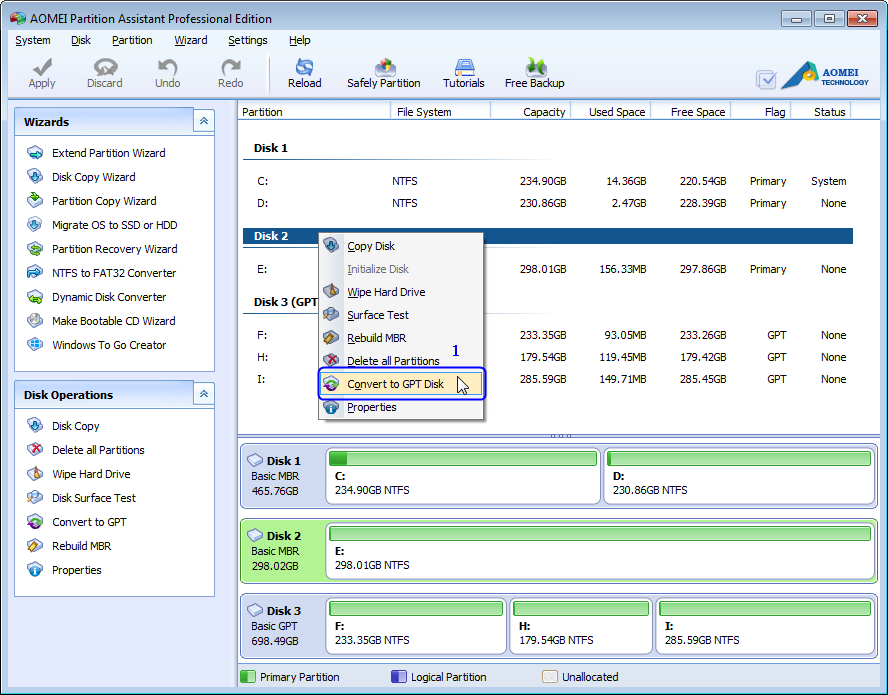(one windows partion only, no EFI partion, windows RE partition, no MSR partition)
decide to change it into UEFI + GPT for boot speed.
here's the procedure that I followed.
1. download AOMEI pro (for converting MBR disk into GPT without data loss, pro version is requreired)
http://malwaretips.com/threads/aomei-partition-assistant-pro-edition-5-5-free-license-key-giveaway.20382/
2. change disk 0 into GPT disk (EFI partion is created autiomatically)

3. resize windows partion for MSR (128 MB), windows RE(300 MB), and recovery image (over 1 GB)
https://technet.microsoft.com/en-us/library/hh825686.aspx

use the DiskPart tool to run the script that automates the configuration of the Windows RE Tools partition, the System, MSR, Windows, and recovery image partitions.
( I did just copied needed command and paste it into diskpart mode in command prompt. for me, blue colored command is needed)
rem == CreatePartitions-UEFI.txt == rem == These commands are used with DiskPart to rem create five partitions rem for a UEFI/GPT-based PC. rem Adjust the partition sizes to fill the drive rem as necessary. == select disk 0 clean convert gpt rem == 1. Windows RE tools partition =============== create partition primary size=300 format quick fs=ntfs label="Windows RE tools" assign letter="T" set id="de94bba4-06d1-4d40-a16a-bfd50179d6ac" gpt attributes=0x8000000000000001 rem == 2. System partition ========================= create partition efi size=100 rem ** NOTE: For Advanced Format 4Kn drives, rem change this value to size = 260 ** format quick fs=fat32 label="System" assign letter="S" rem == 3. Microsoft Reserved (MSR) partition ======= create partition msr size=128 rem == 4. Windows partition ======================== rem == a. Create the Windows partition ========== create partition primary rem == b. Create space for the recovery image === shrink minimum=15000 rem ** NOTE: Update this size to match the size rem of the recovery image ** rem == c. Prepare the Windows partition ========= format quick fs=ntfs label="Windows" assign letter="W" rem === 5. Recovery image partition ================ create partition primary format quick fs=ntfs label="Recovery image" assign letter="R" set id="de94bba4-06d1-4d40-a16a-bfd50179d6ac" gpt attributes=0x8000000000000001 list volume exit
If you want to prevent end users from removing partitions by using disk management tools, you can add the following DiskPart command to the script when you create a partition.
gpt attributes=0x8000000000000001
4. deploy Windows® Recovery Environment (Windows RE)
https://technet.microsoft.com/en-us/library/hh825221.aspx
Create a new directory in the Windows RE Tools partition, and then copy your custom Windows RE tools image (Winre.wim)
mkdir T:\Recovery\WindowsRE
xcopy /h W:\Windows\System32\Recovery\Winre.wim T:\Recovery\WindowsRE
where T: is the drive letter of your Windows RE Tools partition
Register your custom Windows RE tools image:
C:\Windows\System32\Reagentc /setreimage /path T:\Recovery\WindowsRE /target W:\Windows
Optional: If you have added a custom tool to your Windows RE boot image, register it so that it will appear on the Boot Options menu:
Reagentc /setbootshelllink /configfile E:\Recovery\BootMenu\AddDiagnosticsToolToBootMenu.xml
Optional: Configure a hardware recovery button (or button combination) to run a secondary boot path that contains Windows REIn Notepad, create a text file that includes commands to identify and hide the recovery partitions. The following examples are based on your firmware type:
UEFI:
Use the ID: PARTITION_MSFT_RECOVERY_GUID (de94bba4-06d1-4d40-a16a-bfd50179d6ac) to define the partitions as recovery partitions.
Use the GPT attributes: 0x8000000000000001 to hide the drive letters and to mark them as required, by using a combination of two attributes: GPT_BASIC_DATA_ATTRIBUTE_NO_DRIVE_LETTER and GPT_ATTRIBUTE_PLATFORM_REQUIRED.
rem == HideRecoveryPartitions-UEFI.txt
select disk 0
select partition 1
remove
set id=de94bba4-06d1-4d40-a16a-bfd50179d6ac
gpt attributes=0x8000000000000001
rem == If Push-button reset features are included, add the following commands:
rem select partition 5
rem remove
rem set id=de94bba4-06d1-4d40-a16a-bfd50179d6ac
rem gpt attributes=0x8000000000000001
list volume
Run the diskpart script to identify and hide the recovery partitions:
Diskpart /s E:\Recovery\HideRecoveryPartitions-.txt
enter the following command: recimg -CreateImage
Type recimg /showcurrent and press Enter key.
If the last line is "Operation completed successfully", you are ready to go. But if you see error 0x80070490 and message "There is no active custom recovery image", the image is unavailable. Connect your external drive and try again after about 10 seconds.
Sometimes you might want to deregister an image created by someone else - it might be the image provided by your computer manufacturer (that normally includes tons of useless programs) or maybe you bought a used PC.
Again, open elevated Command Prompt - open Start screen (use Windows Key), type "cmd" and click Command Prompt while holding down Ctrl and Shift keys.
Type recimg /deregister and press Enter. Please remember that the custom image file or folder will not be deleted.
If you want to register an existing custom recovery image (you must do that after using Refresh your PC feature), type recimg /setcurrent
How to restore a Custom Recovery Image
Custom Recovery Images can be restored with the Refresh Your PC process. Just plug in the drive where you keep the custom image, use keyboard shortcut Windows Key+I (touch-screen users can swipe in from the right side of screen and tap Settings) to open Settings Charm and click or tap Change PC Settings in the bottom of the bar.Windows 8 users should open General tab on the left and click Get started in the Refresh your PC without affecting your files section.
In Windows 8.1, open Update & recovery tab on the left, then open Recovery tab and click Get started in the Refresh your PC without affecting your files section.
Then follow instructions in Step 3 section of the Repair your computer in Windows 8 and 8.1, page 2 tutorial.
If Windows is not able to boot, you can use Windows installation DVD or Recovery Drive to launch Refresh Your PC.
No comments:
Post a Comment